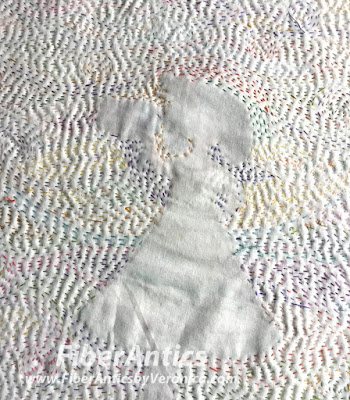 |
| 2017 accomplishments (from top left): Ikat Jacket, knit top, vintage and yarn-dyed mix jacket, Art Weave class, free-motion embroidery, Blue Violets Art Weave sample, Cargo Duffle, improv pieced mug rug, Cargo Duffle briefcase. |
 |
| A jacket inspired by vintage textiles. |
My enthusiasm for garment sewing and creating artwear pieces has been renewed—due in large part to the fabric companies I represent that offer fabulous, high quality woven and knit fabrics that are great for sewing clothing as well as quiltmaking. When ya work with "the good stuff," you're more inspired, the projects come out so much better, they wash and wear well, and the "making process" is waaaay more enjoyable.
Oh... and you don't look like the run-of-the-mill chain store Jo (or Joe). We're all different and unique! Let's not dress like twinsies.
I made two jackets this year that I am pleased with the results. I get lots of compliments on them, too. Each one coincided with an industry trade show (Spring and Fall Quilt Markets) and feature the luscious yarn-dyed wovens from Diamond Textiles. No doubt it was a firm deadline that facilitated these projects into the "completed" column. "There's nothing like a deadline to get one motivated," as the saying goes. I also have a selection of knit tops—short and long sleeves—made with Art Gallery knits.
 |
| Ikat jacket with Primitive Stars fabric. |
Vintage Inspiration and Collaboration with Anonymous
In the Spring of 2017, my quilt guilds brought author and award-winning quiltmaker, Mary Kerr, to Chattanooga for workshops and a lecture. Mary has written books about incorporating vintage textiles and antique quilt blocks into new quilts. The collar on the white jacket (shown above) and this Vintage Wonky Star quilt top (below) were the results of Mary's visit. It was fun to collaborate with the anonymous quilters who made and left behind the original quilt blocks.
 |
| Vintage Churn Dash quilt blocks made into A Wonky Star. An unquilted quilt top made in a workshop with Mary Kerr. |
Machine quilting and stitching
I expanded my free-motion quilting to include a new substrate—canvas. I used the Cargo Duffle pattern (with mods) from Noodlehead to construct two zippered bags. I rep two companies—Alexander Henry and Art Gallery Fabrics—that offer cotton canvas fabrics.
 |
| Variation of Cargo Duffle with canvas fabric from Alexander Henry Fabrics. Stripe fabric from Diamond Textiles. |
The variegated 50 wt. cotton thread [Tutti from WonderFil Specialty Threads] is still one of my favorites. The contrast striped fabric is one of the World Fabrics from Diamond Textiles.
 |
| Free-motion machine quilting on canvas with variegated thread. Canvas: Alexander Henry fabrics, Thread: WonderFil Tutti 50 wt. |
WonderFil's 12wt. cotton thread [Spaghetti] prompted experimentation with machine decorative stitches. The 4-patch blocks are made with the versatile yarn-dyed wovens from Diamond Textiles that were also used in my jackets.
 |
| Decorative machine stitching with 12 wt. thread [WonderFil Threads] on yarn-dyed textured wovens by Diamond Textiles. |
Inspired by a studio intensive workshop with Dorothy Caldwell, my take-along travel projects now involve hand stitching.
 |
| Kantha stitched cover for Mark Making book from Dorothy Caldwell workshop. |
Although the stitching on my patriotic girl is now complete, I haven't decided if this piece will become a pillow or a small quilt.
 |
| Hand embroidery with ArtPlay Stitcheries from ADORNit. |
 |
| The background of the embroidery is filled with kantha stitching. The base fabric: yarn-dyed woven from Diamond Textiles. |
Quilting for Charity
 |
| Jesse inspects the kitty quilts donated to the kitties at the Cat Clinic. |
Both of my quilt guilds were generous with their time and resources in 2017. I don't think I completed any cuddle quilts all myself, but I donated a bag of fabric swatches to my quilt guild for a year of "Make Do" and improvisational patchwork. The swatches found their way into quilt blocks I pieced and several charity quilts our guild members worked on together.
 |
| Cuddle quilts quilted at the Choo Choo Quilters annual workshop. |
At our annual Cuddle Quilt workshop, I was able to free-motion quilt 5 cuddle quilts, so I was part of the team effort. I supported the other guild with a quilt top for a Re-mix Exercise. This quilt will be donated to Chattanooga's Habitat for Humanity organization. The finished quilt can be seen here.
Inspiration, Encouragement and Support
As makers and artists, we don't do our craft alone. We're influenced by the art and artists of both the past and present. And... if we're lucky enough, we can meet, learn from and work with today's talented artists and entrepreneurs that strive to bring their best work into the world... so we can make and do our best work. Here are just a few of them...
 |
| From top left, Row 1: Larry, my personal cheerleader and indefatigable supporter; Leesa Chandler from The Textile Pantry; Rohni Sandu from Diamond Textiles. Row 2: Me and Mary W. Kerr; representing all shop owners is Donna Sandidge (right); Patrick Lose and I. Row 3: woodblock printing artist Hiroki Moriroue; fiber artist Dorothy Caldwell and I; friends from my quilt guild at our Cuddle Quilt workshop. |
I have also had the pleasure of being inspired by the students who attend my classes and my fellow classmates who have been in workshops alongside me. And, it's a pleasure to work with owners and associates of numerous quilt shops and independent sewing centers this past year. These shop owners are some of the hardest working, dedicated, small business people around. Please support them!
 |
| From the road. |





































